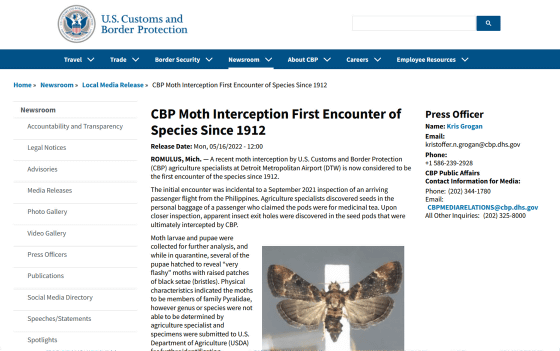Larvae and pupae of 'rare moths that have not been witnessed since 1912' are found in passenger bags arriving at the airport, emerged during quarantine and become adults

by US Customs and Border Protection
'Moth larvae and pupae that have not been witnessed for more than 100 years' were found in the bags of passengers arriving at
CBP Moth Interception First Encounter of Species Since 1912 | US Customs and Border Protection
https://www.cbp.gov/newsroom/local-media-release/cbp-moth-interception-first-encounter-species-1912

'Very flashy' moth not seen in more than a century found in bag at Detroit airport
https://www.nbcnews.com/news/us-news/-flashy-moth-not-seen-century-found-bag-detroit-airport-rcna29329
Moth Species Not Seen Since 1912 Was Intercepted at Detroit Airport --The New York Times
https://www.nytimes.com/2022/05/23/science/moth-species-discovery-detroit.html
US Customs Agents Find Rare Moth Last Spotted in 1912 | Smart News | Smithsonian Magazine
https://www.smithsonianmag.com/smart-news/us-customs-agents-find-rare-moth-last-spotted-in-1912-180980140/
The United States Customs and Border Protection said in a statement on May 16, 2022, 'The bag of passengers who left the Philippines in September 2021 and arrived at Detroit Metropolitan International Airport had no sightings since 1912. Larvae and sanagi were found. '
The baggage in question was described by passengers as 'medicinal tea seeds,' but customs officials investigated it in detail and found that some seeds had holes that were apparently made by insects. rice field. Later, unidentified larvae and pupae were discovered by a customs farmer. The picture below shows the seeds in which the larvae and pupae in question were found.

by US Customs and Border Protection
The found larvae and pupae were quarantined for quarantine, but during the quarantine the pupae emerged and became 'very flashy moths'. However, although this moth was presumed to be a member of the
Dr. M. Alma Solis, an entomologist at the U.S. Department of Agriculture, who specializes in moths, has analyzed specimens of adult moths, pupae, and larvae and has lost sight of them since they were discovered in Sri Lanka in 1912. It turned out to be a species called ' Salma brachyscopalis Hampson '. It was the first time in a century that an individual was found, and this is the first time that larvae and pupae have been collected.
The photo below is a specimen of Salma brachyscopalis Hampson that actually emerged during quarantine. 'He's a great entomologist,' said Dr. Solis, who claimed the findings were amazing and said he worked with Tyler Fox, an agricultural expert at Customs and Border Protection.

by US Customs and Border Protection
Although the Salma brachyscopalis Hampson discovered this time is a very rare individual, it is unlikely that passengers brought it in for smuggling purposes because the commercial and aesthetic value of the moth itself has not been recognized. However, it is very important for Customs to discover, identify and eliminate these alien species, as bringing in alien species can have a significant impact on existing ecosystems and agriculture.
'Customs agricultural experts play an important role in domestic ports of entry to prevent harmful exotic plants, pests, animals and diseases from being brought into the United States,' said Robert Larkin, Director of the Federal Port Authority. This discovery underscores their important mission to identify foreign pests and protect America's natural resources. '
Related Posts:
in Creature, Posted by log1h_ik







